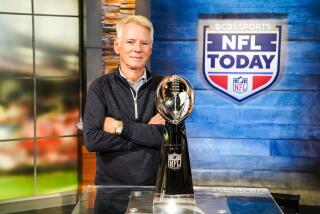Hank Stram, 82; Won More Games Than Any Other Coach in the AFL
- Share via
Hank Stram, the most successful coach in American Football League history and a TV and radio broadcaster for nearly two decades, died Monday in a suburban New Orleans hospital. He was 82.
Stram died at St. Tammany Parish Hospital near his home in Covington, La., across Lake Pontchartrain from New Orleans. He had been in declining health for several years, and son Dale Stram attributed the death to complications from diabetes.
The coach, a member of the Pro Football Hall of Fame, was credited with developing the 3-4 defense, the two-tight-end formation and the moving pocket. Later, he worked as an analyst for CBS, first on television and then in the radio booth, where he called “Monday Night Football” alongside Jack Buck.
Stram did radio commentary for four Super Bowls, becoming the first person to participate in the NFL championship game both as a winning coach, with the Kansas City Chiefs, and as a broadcaster.
“I’ve lived a charmed life,” he once said. “I married the only girl I ever loved, and being able to do a job I truly loved with the Chiefs, I’m a lucky fellow.”
Chiefs owner Lamar Hunt told Associated Press: “Pro football has lost one of its most innovative and creative coaches and one of its most innovative and creative personalities as well.”
Stram, who had suffered from diabetes for several years, was inducted into the Pro Football Hall of Fame in 2003.
“Look at all the red eyes,” former Kansas City running back Ed Podolak said at the time. “I cried like a baby, and so did everyone else.”
Stram set league records by winning three championships and more games than any other AFL coach. He was coach of the Dallas Texans and stayed with the team when it became the Kansas City Chiefs. After the leagues merged, he moved on to the New Orleans Saints.
“When it came to football, Hank knew everything about everything,” said kicker Jan Stenerud, one of several Hall of Fame players he coached.
Three years after losing the inaugural Super Bowl to the Green Bay Packers, 35-10, Stram’s Kansas City team upset the heavily favored Minnesota Vikings, 23-7, in Super Bowl IV. It was the second consecutive Super Bowl victory by an AFL team and was further proof the NFL had met its match.
The AFL’s New York Jets helped the league gain respectability by beating the NFL’s Baltimore Colts in Super Bowl III. Some people dismissed that as a fluke, but there was no denying the Chiefs dominated the Vikings.
“That got the attention of everybody,” said former Kansas City quarterback Len Dawson, who presented Stram at the Hall of Fame. “People said, ‘Hey, wait a minute, who are those people playing out there? And how did they dominate that Minnesota team?’ ”
For several years, Stram was the only coach not in the Hall of Fame among those who won the first 14 Super Bowls. He finally was elected by the hall’s seniors committee.
“If you look at the man’s contributions to the game, as an innovator, as a pioneer, as a character, the players who played for him, his record.... If you look at the entire picture, Hank Stram is like one of the founding fathers,” one of his former players, Mike Adamle, said in 2000.
Stram designed the moving pocket and the two-tight-end formation to buy extra time for Dawson, and he devised the 3-4 defense -- referring to three down linemen and four linebackers -- in an era when other coaches were using a 4-3.
Against the advice of other coaches who said a zone defense wouldn’t work in pro football, Stram used the strategy throughout the 1962 AFL Championship game, and his Texans intercepted five George Blanda passes on their way to a 20-17 double-overtime victory over Houston.
In his 1970 book, “Illustrated History of Pro Football,” Robert Smith compared Stram to legendary Cleveland Browns coach Paul Brown and said Stram took football “to a higher intellectual plane or at least developed it in the direction of an academic discipline.”
But Stram was known for his quirky sense of humor in an era when most high-profile coaches took themselves very seriously. He gave everyone nicknames.
“Hank had his own vocabulary,” said Steve Sabol, president of NFL Films. “Hank was the Mentor. His players were called the Rats. The Chiefs didn’t drive the ball, they matriculated the ball. Team priests were called blackbirds. The refs were called sausage stuffers.”
Sabol was the cameraman who kept his lens trained on Stram during Super Bowl IV. It was the first time a coach had worn a microphone in a championship game, and the gregarious Stram was a highly amusing subject.
Sabol and his father, Ed, founder of NFL Films, chose to put a microphone on the media-savvy Stram because they felt he, if anyone, understood the move. He still needed some convincing.
“When we went to [put a microphone on] Hank, the first thing he said was, ‘Is any coin of the realm going to exchange hands?’ ” the younger Sabol recalled. “And my father and I looked at each other and we didn’t know what he was talking about: ‘What do you mean, coin of the realm?’ So Hank says, ‘The Mentor is not going to wear a mike unless there are some dead presidents involved here.’”
They offered him $500, but Stram said that wouldn’t cover his dry-cleaning bill for a week. They increased the offer to $1,000 and he agreed. As it turned out, he was well worth the money. He stormed up and down the sideline in his familiar blazer, rolled-up game plan in his hand, chattering away with officials and his players.
“I knew Hank was funny, but I never expected him to be that loose during a world championship game,” Sabol said. “It was like having Henny Youngman coach a football team. Everything was a one-liner.”
Dawson said Stram was always able to keep the game in perspective, even though he was very serious about his coaching. Losses didn’t haunt him.
“Hank had the ability to let it go,” he said. “Some coaches would get hot and angry and be steamed up for three or four games. Hank was very disappointed when we lost, but he was so connected to football and coaching that his mind clicked on to next week, disappointed that they lost, but looking forward to the next challenge.”
Henry Louis Stram was born in Chicago but spent much of his youth in Gary, Ind., where he was an all-state halfback in football and also starred in baseball.
After serving in the Army Air Forces during World War II, Stram returned to Purdue University, graduating with a degree in physical education. He also played football and baseball for the Purdue Boilermakers.
After graduation, he stayed at Purdue for seven years as a backfield coach in football and as coach of the baseball team. He later coached at Southern Methodist University and Notre Dame. He was an assistant coach at the University of Miami and had not been a head football coach until went to the Texans.
Stram is survived by his wife of 52 years, the former Phyllis Marie Pesha; four sons, Henry, Dale, Stu and Gary; two daughters, Julia and Mary Nell; and a sister, Dolly.
Private services are being planned.
More to Read
Go beyond the scoreboard
Get the latest on L.A.'s teams in the daily Sports Report newsletter.
You may occasionally receive promotional content from the Los Angeles Times.











